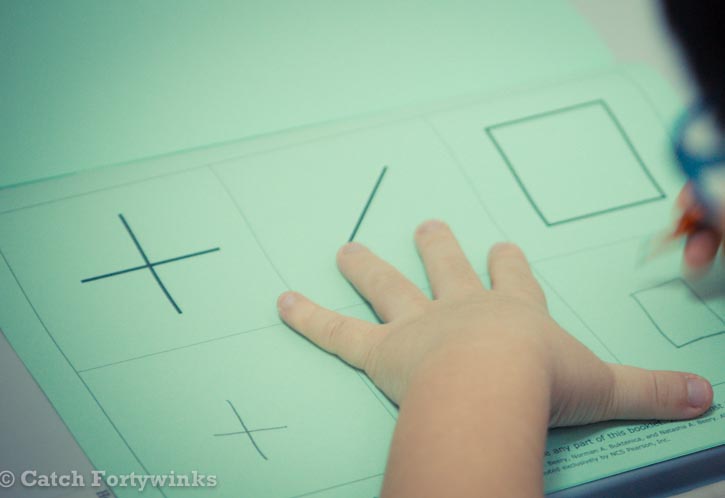Besides having a slight ‘impaired’ vision with his lazy eye problem., K hardly listens to my instructions when he has to complete a task, despite gentle and persistent reminders.
I have realized that gentle does not quite work, since I have to repeat the same thing at least 3-4 times, coupled with a fairly loud and stern voice, until he finally acknowledges and follows through with the instructions. So I have long come to this conclusion that he needed some help in improving his listening skills.
Until he recently underwent an assessment test and I was rather surprised by the results.
I was introduced to the concept of brain fitness by Brainfit Studio and invited to review their programme by testing it out with K for 10 weeks. Part of this programme included this cognitive assessment test to determine the K’s cognitive strengths and weaknesses, and the results of this brain profiling test will be used to personalize a brain fitness programme for K.
Brain fitness is an unfamiliar concept for me, based on its definition on Wikipedia, ‘brain fitness reflects a hypothesis that cognitive abilities can be maintained or improved by exercising the brain, in analogy to the way physical fitness is improved by exercising the body.’ Rather similar to the concept that high levels of mental activity is associated with less risk of age-related dementia.
So how does Brain fitness work for a 6 year old child? Here is Brainfit Studio take on it. Their proprietary CognitiveMap assessment measures the child’s cognitive skills, and identify areas that can be improved. These are series of standardized tests that are used to measure the areas in the 5 brain pillars of Visual, Sensory-Motor, Auditory, Attention and Memory and Socio-Emotional.
In this first two parts of my review post for the Brainfit programme, I will detail the type of tests that K experienced and the results of his assessment.
1. Visual i) This test of Visual Perception Skills measures the child’s ability to interpret what he sees – Visual Sequential Memory
 This test measured K’s ability to remember the sequence of a series of forms.
This test measured K’s ability to remember the sequence of a series of forms.
ii) Developmental test of Visual-Motor Integration

This evaluates K’s ability to coordinate his visual perception skills with finger / hand movements. He was asked to look at visual patterns (got more difficult as he continued) and he had to draw them as accurately as possible, without using a ruler.
iii) Developmental Eye Movement Test

This measure skills required for reading tasks, K had to name the series of numbers in succession as quickly as he could. This test assessed number fluency, eye control speed (reading the numbers from left to right, horizontal then vertical) and measures eye control accuracy. These were useful tests that could determine possible reading difficulties that the child may have.
iv) Handwriting speed test
As K is only 6 years old, the speed of his handwriting was not the key indicator for this test. Rather, other factors like his pencil grasp, print pressure, alignment , sizing and spacing between letters and words were assessed.

According to the report by Brainfit, handwriting may reflect a child’s under-lying sensory-motor skills, cognition, memory, perception and motivation.
2. Auditory
i) The test of Auditory Perceptual Skills assesses the auditory skills needed for the use, development and understanding of language commonly utilized in academic and daily activities.

K was told by the assessor to close his eyes so that he could focus on the series of auditory tests that followed :
ii) Word Discrimination – this measure K’s ability to detect differences in the initial, middle or end segments of one and two-syllable words presented verbally. Phonological Segmentation determined how well he could manipulate phonemes (the smallest unit of sound within words). Number memory (Digits forward and Reverse) measured his rote memory of sequence of verbal information. Word and Sentence Memory measured the number of words in a series (one, two syllable and compound words) that he can recall, and retain details in sentences of increasingly length and grammatical complexity.
3. Sensory-Motor
The Movement Assessment Battery for children evaluates the motor coordination abilities of children that are important for school and social performance
i) Manual Dexterity measures the child’s fine motor skills involving hand and finger manipulation, important for developing handwriting skills.

Key activities that were incorporated to measure dexterity were threading beads, posting coins and drawing a trail.
ii) Aiming and Catching activities measure the child’s hand-eye coordination through throw and catch activities; Throwing beanbag onto mat and Catching Beanbag

iii) Balance evaluates the child’s ability to coordinate the body in balancing tasks

Activities include; One-leg balance, Walking Heels Raised and Jumping on Mats.
4. Attention and Memory
The Integrated Visual and Auditory Continuous Performance Test is a computerized test if attention which measures responses to 500 intermixed visual and auditory stimuli spaced 1.5 seconds apart. The child has to click the mouse when he hears or sees ‘1’ on the screen, and refrain from clicking when he hears or sees ‘2’.

This activity evaluates impulse control, or acting without thinking, and visual and auditory attention.
5. Social Skills
The Social Skills improvement system evaluates a child’s social skills based on a questionnaire that I had to complete. The results were subjective to my assessment of what I knew from K’s behavior, so the results will not be included in this review post.
Through these tests, I realized that there is only so much that a parent can understand from her child’s development through observation, by spending one-on-one time together and with some home-learning experiences with the child. So I was rather surprised with some of the results from this Cognitive assessment test. Stay tuned to read the next post for the results of the assessment test from Part 2 of Brainfit Studio A Review next week.
Location of BrainFit Centres :
BrainFit Studio, Novena : 193 – 197 Thomson Road Goldhill Centre Singapore 307633 Tel: 6737 3511 Fax: 6737 4533
BrainFit Studio, East : 83, East Coast Road Singapore 428786 Tel: 6346 4386
BrainFit Studio, Serangoon Garden : 74 & 74A Serangoon Garden Way Singapore 555970 Tel : 6281 1343
Disclosure : I was sponsored CognitiveMap Assessment by Brainfit for the purpose of this review. Descriptions of the assessment tests shared in this post are from an assessment report of K provided by Brainfit Studios, but all opinions are my own.




















I’m worried about C’s listening too. Although sometimes I feel it’s all selective, because he chooses what he responds to!
This is interesting. Classes start only for 6 year olds?
Regina´s last blog post ..We all have bad days.
I think Isaac needs this. He does not listen at all!
WOW just what I was looking for. Came here by searching for Brainfit Studio
ask´s last blog post ..ask
Hi, did the brainfit program improve your child’s weaknesses? And how long does it take before you saw results?